


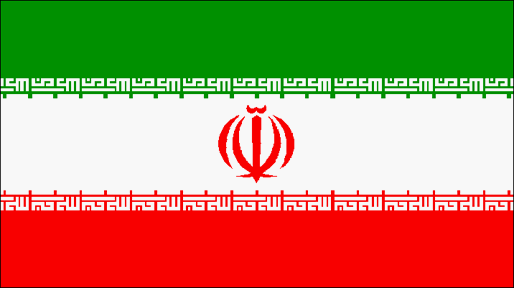
Shahab-3 / Zelzal-3
| Technical Details |
| |
| Range (km) |
Basic: 1,280 km (800 miles)
Variant: 1,903+ km (1,200 miles) |
| CEP (m) |
190
(Previously thought to be
several thousand meters) |
| Diam. (m) |
1.32-1.35 |
| Height (m) |
15.852-16 |
| L. W. (kg) |
15,852-16,250 |
| Stage Mass (kg) |
15,092 |
| D. W. (kg) |
1,780-2,180 |
| Thrust (Kg f) |
Effective: 26,051 (-709)
Actual: 26,760-26,600 |
| Burn time (sec.) |
110 |
| Isp. (sec.) |
Effective: 226 - SL due to vains
steering drag loss of 4-5 sec.
Actual: 230
Vac.: 264 |
| Thrust Chamb. |
1 |
| Fuel |
Liquid (TM-185)
20% Gasoline
80% Kerosene |
| Oxidizer |
AK-27I
27% N2O4
73% HNO3
Iodium Inhibitor |
| Propellant Mass (kg) |
12,912 |
| Warhead (kg) |
760-987-1,158 |
| Type |
MRBM |
The Iranian Shahab-3 is a single-stage, liquid-fueled, road-mobile,
medium-range ballistic missile with a range of approximately 800 miles (1,280
km). A MRBM variant, sometimes called Shahab-4, has a range of more than 1,200
miles (1,930 km).
Shahab-3 is capable of carrying a 1,000-760 kilogram warhead. Fewer than 20
launchers were deployed as of March 2006, according to Air Force Intelligence.
The variant was not deployed at the time.
Shahab-3 means Meteor-3 or Shooting Star-3 in Farsi [alternatively designated Zelzal (Earthquake)] is derivative from the 1,300-1,500 kilometer range North Korean No-dong missile.
Design Heritage
The No-dong ballistic missile was developed by the North Korean's with Soviet Gorbachev era technical participation along with Chinese contributions and Iranian financial assistance. The former Soviet Union's technology transfer contribution is circumstantially strongly suspected as having come from the Acad. V. P. Makeyev OKB Design Bureau developers of the Soviet era Scud-B, and its follow on SLBM's and the Isayev OKB, S-2.713 rocket engine design which was used on the Soviet SS-N-4 SLBM. This was directly the results of strategic arms reduction treaties creating unemployment in a large Cadre of technically qualified personnel in the Makeyev OKB's essentially cancelled liquid propellant SLBM programs of the Former Soviet Union since no other form of employment was successfully offered to them. That highly modified Isayev OKB, S-2.713M rocket engine design strongly reflects its Scud-B design heritage but represents an entirely new liquid propellant rocket engine far beyond the growth potential of the modified Scud-B and C class engines for application to the No-dong. That No-dong engine also reflects modern Soviet rocket engine start up design technology such as the solid charge starter to spin up the turbo-pump, instead of start up propellant tanks, and the pyrotechnics used to open the propellant flow and to cut it off. It also reflects the typical on off rocket engine design philosophy used by the Soviets. All Soviet era SLBM's owe their design heritage to the Scud-A and Scud-B tactical ballistic missiles. China's contribution to the No-dong project came from the joint North Korean/Chinese project conducted between 1976-78, the cancelled DF-61 missile, essentially a Scud-C capability ballistic missile with a range of 600 km. carrying a 1,000 kg warhead that also featured a strap-down guidance system. Iran in fact decided to totally rework the North Korean No-dong design to their liking with Russian and now Chinese help but they have yet to successfully indigenously produce the whole vehicle to North Korea's standards.
|
Shahab-3 MRBM
Variants |
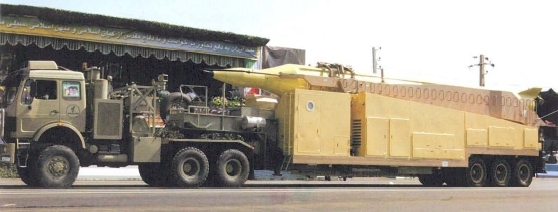 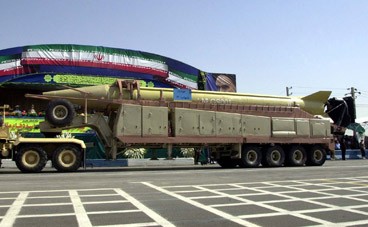 |
|
Iran had developed two variants of the Sharab-3 MRBM.
The original version (left) has a range of approximately 800 miles
(1,280 km), while a new variant (right) has a range of more than
1,200 miles (1,930 km). The variant is longer to carry more fuel and
carries a different warhead (possibly cluster munitions). |
Build Up and flight Test Analysis
Iran was slated to receive the first shipment of the missiles late in 1993. However the delivery was halted due to American pressure on North Korea. According to some reports, as of 1995 Iran had not received the missiles. However Israeli press reports in 1996 cited intelligence reports which claimed that at least a dozen No-dong missiles had been delivered to Iran from North Korea. But General Peay, USCINCCENT, claimed during a spring 1996 interview that attempts by Iran to buy No-dong missile from North Korea had failed for financial reasons. The Washington Times, on September 11,1997 reported that Iran had received from China's, Great Wall Industries Corporation, "guidance, and Solid propellant motor technology as well as general missile testing technology. The Shahab-3 and 4 programs appear to be getting considerable assistance from China and Russia.(1) For the first time publicly the Shahab-3 and Shahab-4 missile programs were identified in this article. Shahab-3 is said to have a range of 930 miles (1,496 km.) while the Shahab-4 is credited with 1,240 miles (1,995 km.) the prototype of which was expected to be only 2-3 years away.(1)
U.S. Air Force Intelligence says the range of Sharab-3 is 800 miles (1,280 km),
while the Sharab-3 variant (called Sharab-4 by some) has a range of more than
1,200 miles (1,930 km).(23)This was followed on October 18, 1997 in The Washington Times, with the information that "Iran is just three years (2000) from fielding the first of two versions of the North Korean, No-dong missile called the Shahab-3 and 4�..".(2) However, active Iranian development of this missile continued. According to mid-1997 Israeli reports, at the rate of current development, the project will be completed and operational within two years -- by the end of 1999.
On 15 December 1997 satellite reconnaissance of the Shahid Hemat Industrial Group research facility, just south of Tehran, Iran detected the heat signature of an engine static test firing for this new missile. The test was either the sixth or eighth conducted in 1997, depending on conflicting interpretations of available intelligence. It is believed that Iran may have purchased up to 10 of these No-Dong missiles from North Korea. Iran's missile design bureau organizations for their Shahab-3 missile are made up of the Shahid Hemat Industrial Group (SHIG) and the Shahid Bagheri Indusral Group (SBIG).
It was further revealed by the Washington Times on June 16, 1998 that Iran had purchased "telemetry equipment" from China for missile test monitoring "China Great Wall Industries" provided an entire "Telemetry infrastructure" for the Shahab-3 and 4 MRBM based on No-dong. China was also said to have helped in the Iranian NP-110 short-range tactical solid propellant missile project with a 105 miles (168.95 km) range project. (3) The CIA predicts that the first test flight of the Shahab-3 would occur in 1998, while the DIA predicted a first flight test would occur in 1999. The tests of the missile engines, according to US intelligence, used monitoring equipment supplied by Russian sources.
On July 22,1998 Iran conducted the first flight test of the Shahab-3 MRBM missile based on No-dong. The following information was revealed about this test in the Washington Times, on July 24, 1998, "The missile exploded 100 seconds after launch ---- after having traveled about 620 miles (997.58 km. down range) over a missile test (range) site in Northern Iran. --- It is uncertain whether that was an accidental explosion or they terminated the flight after achieving what they had to do or because of other reasons." (4) This certainly indicates that the flight was not a total failure but at least a partial success. The Washington Post added it would take one or two years before the Shahab-3 MRBM would be deployed and that, "One government expert described it as "a flight-test for technical purposes" in which the dummy warhead exploded before hitting the ground well down (the test) range." (5)
The missile was launched at 06:00 from a firing range about 100 miles southeast of At (Qom?) Two or three American early warning and SIGINT signal intelligence satellites detected this first launch of the Shahab-3 ballistic missile. After launch the missile flew approximately 100 seconds to the southeast. The rocket exploded or was deliberately detonated about 100 seconds into the 110 seconds burn of the single stage, either because of engine steering vains disintegration failure or instrumentation/guidance failure which may have caused the premature warhead detonation. There is also the possibility that the Iranian's, were satisfied with its Shahab-3 rockets performance, and had decided to detonate it by remote control. However this is highly questionable as a missile testing procedure. Almost certainly the missile had gone out of control and was deliberately destroyed. The flight ended near the time the fuel on the single stage missile would have been exhausted at 110 seconds from start up, at which point in an operational flight, the warhead would normally separate from the missile and fly to its target.
Due to the missile's mid-air explosion, which was picked up by American satellites, it was initially believed that the test was at least a partial failure. However, following careful examination of the initial technical data, some experts reportedly concluded that the test was in fact successful. They were wrong. The US Government expected that there would be additional tests, and that several more tests would be required before Iran was confident of the abilities of the missile. The Washington Times also suggest that the CIA knew that the flight would be in 1998 and also knew of the flight being prepared "first test was imminent."(6) It was to be a modified No-dong missile.
In passing it is interesting to note that Pakistan flew its direct copy No-dong missile (Ghauri-II) on April 6, 1998 some three months before Iran's Shahab-3. The question is why and what does this imply? It would seem to imply that Iran reworked the North Korean No-dong design while Pakistan bought the whole package missile and its (TEL) Transport Erector Launcher and its simpler mobile support equipment. Iran apparently not only reworked the No-dong design but also developed its own Mercedes Benz based (TEL) and its extensive separate mobile support equipment but has also probably done the same reworking the two Taep'o-dong launch vehicle designs.
On February 7, 1999 Iran's Defense Minister Ali Shamkani said the following as documented in The Washington Times on March 2,1999 "confirmed that the Shahab-3 is now in production, and that no further flight test are needed."(7)
Florida Today stated that Iran's defense minister Ali Shamkhani's had said, "The Shahab-3 missile is the last military missile Iran will produce,--- We have no plans for another war missile."(8)
By March 1999, fifteen Shahab-3 missiles would have been produced domestically by Iran based on the Defense Ministers comments after the July 22, 1998 flight test. Reuters, on September 19, 1999 noted that Tehran "struts missile Zelzal which took 4.5 years to develop."(9)
|
Sharab-3 SRBM
Launch |
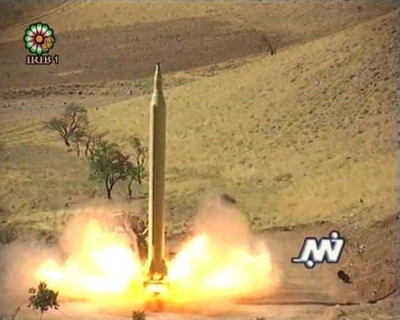 |
|
A Sharab-3 SRBM is launched from the rear of a
six-axel transport erector launcher. |
The Washington Times, on September 22, 1999 quoted the Air Intelligence Agency, National Air Intelligence Center of Wright-Patterson Air Force Base, Ohio report entitled "Ballistic and Cruise Missile Threat." Which discussed several issues related to the Iranian missile programs. Those quoted comments from the NAIC publication were as follows:
"Iran is working on the development of at least two medium-range ballistic missiles, The Shahab-3 and Shahab-4.(10)
On February 9, 2000, The Washington Times revealed the following
details on North Korea's acquired help from Iran: "North Korea recently sold Iran a dozen medium range ballistic missile engines"
[in November 1999]. "The (12) engines arrived in Iran on Nov. 21, after they were spotted being loaded aboard an Iran Air Boeing 747 cargo jet that left Suinan International Airfield about 12 miles north of...Pyongyang." These are the same engines used in No-dong."(11)
Quoting from "Mr. Robert Walpole National Intelligence officer for Strategic and nuclear programs from Congressional testimony in the Washington Times of February 10, 2000 "Those engines are critical to the Taep'o-dong Program,-----of the North Korean's Long-range missile. And They would be critical to the Shahab-3 program and any extensions of the Shahab-3 program."
--------" The CIA analysis also said North Korea has not stopped developing its Taep'o-dong long-range missile----".(12) The CIA considered the No-dong derived Shahab-3 to be operational as of February 2000.
According to Jane's Defence Weekly, of March 22, 2000, suggest that "Iran on Feb. 20, 2000 carried out an operational test on a Shahab-3 missile in country. ---- It was launched from a TEL from a new base of the IRGC at Mushhad. The Shahab-3 used a inertial guidance system with a CEP Circular error probability of 3 km." (13)
It remains unclear how accurate this report is based on subsequent events in the Iran's ballistic missile program development. This appears to actually have been a vehicle engine static test firing to test the vehicle systems and engine operation integration.
Additionally it would also appear that a cluster of Shahab-3 class engine was static tested during February 2000 in Iran but only the subsequent history seems to confirm this event. This is separate from the North Korean engine static test firings and from the subsequent launch pad Taep'o-dong-2 first stage systems integration vertical static test firing conducted during the week of June 26th through July 2, 2001.
Iran successfully conducted a full end to end flight test of a Shahab-3 on 15 July 2000. Following the test, the Iranian Defense Ministry told Iranian State television that the Islamic Republic had no intention of using its missiles to attack other countries. This launch appeared to have been quite successful. This launch vehicle probably utilized one of the engines purchased from North Korea instead of a domestically produced engine.
Iran carried out a second flight test of the Shahab-3 as noted in a Reuters news reports, in The Washington Times, July 16, 2000, on July 15, 2000 test which achieved a velocity of 4,320 mph (1,931.04 M/sec.) with a 1 ton warhead. (14)
Another flight test of the Shahab-3 was predicted by the Washington Times on Sept 8, 2000, --- "delayed from the previous week "---. ---"test expected later this month" ---.(15)
Iran then conducted a further third test launch of Shahab-3 or 3D on September 21, 2000, but the missile apparently failed or exploded shortly after liftoff.
On Sept 21, 2000 the Voice of the Islamic Republic of Iran Radio-1, stated the following, "The first Shahab-3D missile using liquid and solid fuel, was successfully test-fired on the first day of the Holy Defense Week. Announcing the news the Minister of Defense and armed forces logistic said: The missile was built and tested for the purpose of gaining the necessary technology in order to enter the design and production stage of Satellite guidance systems. Vice-Admiral Shamkhani added: The Shahab-3D missile has no military use and only for achieving the preliminary stage of new non-military operations." (16)
The Associated Press further stated, "Iran has successfully test-fired its first solid-liquid fueled missile, which the Defense Minister said was part of a program for launching satellites, ----" (17)
The Washington Times on September 22, 2000 added that the Iranian had tested the Shahab-3D, MRBM for a third time, but the "the rocket exploded shortly after liftoff, U. S. Intelligence officials said ��." " Defense Minister Ali Shamkhani told the official IRNA News Agency that the test of the Shahab-3D-----". The Iranian spokesman went on to say that the missile was "solid and liquid fueled" and will be used only for launching communications satellites and not warheads." (18)
Jane's Intelligence Review, in its November 2000 issue stated the following "The Sept. 21, 2000 flight test was a failure according to U. S. officials. It was flown from near the city of Semnan ." (19)
On September 21, 2000 during testimony before the U.S Senate Mr. Walpole National Intelligence officer for Strategic and nuclear programs discussed the Shahab-3D first launch.
Mr. Walpole " Iran's Defense minister announced the Shahab-4, originally calling it a more capable ballistic missile than the Shahab-3, but later categorizing it as a space launch vehicle with no military applications. -------
Sen. Cochran,
"As we have said in open session before, Iran procured No-dong and then sought Russian assistance to modify that into the Shahab-3, which is a little different approach than Pakistan used to get the Ghauri, which is also a No-dong. They did not mind trying to change it. They just decided to change its name and buy them outright." (20)
The Shahab-3D test was detected by US space sensors, and announced by an Iranian government spokesman in Tehran. Although Iran claimed the test-launch was a success, US officials said the Shahab-3D exploded shortly after launching. Defense Minister Ali Shamkhani stated that the test of a "Shahab-3D" was conducted in connection with the anniversary of the start of the war with Iraq, which began in 1980 and ended in 1988. The Iranian spokesman said the missile was "liquid and solid-fueled" and would be used for launching communications satellites and not warheads. Iranian sources characterized the missile as being "liquid and solid fueled" but it is known that the Shahab-3 missile consisted of a single liquid propellant first stage. If a smaller solid propellant second stage were added to the Warhead or as a payload boost stage then this would be perhaps the first appearance of the "IRIS" launch vehicle. The IRIS launch vehicle is a Iranian space program related derivation of the Shahab-3 ballistic missile. A launch vehicle of this configuration is ideal as a vertical probe sounding rocket but would almost certainly not be capable of launching a satellite of appreciable mass or capability unless it were intended to be a second and third stage of a larger launch vehicle. However, it would finally give the Shahab-3 missile the range required to cover all of Israel.
Early in 2001 it appeared Iran was preparing for another flight test of the Shahab-3 missile as noted in the January 12, 2001, The Washington Times. "Iran is preparing to conduct another flight test soon-----" full range " flight test gauged a failure on Sept 21, 2000 but it was successful on its second flight test. (21)
More North Korean produced No-dong class storable liquid propellant rocket engines were apparently shipped to Iran in spite of being held up by a financial disagreement that had delayed the shipment, according to the Washington Times of April 27, 2001. " New shipments of North Korean missile components and technology ----". The article went on to state that the latest shipment of missile parts and their associated documentation was shipped in late February 2000 from North Korea's Sunan international airport which is north of Pyongyang. (22)
This second shipment was apparently delivered to Iran after April 2001. Presumably this latest shipment to Iran from North Korea was flown over China with its permission as was done previously for other shipments.
There have been only a few test firings of the No-dong missile and its direct copy Pakistan's, Ghauri-II
and improved Iranian Shahab-3 descendants:
- The first known flight test of No-dong occurred in North Korea on May 29 or 30th 1993. Based on the long known historical record from the U.S. Intelligence Experience of failing to detect first flight test of various countries ballistic missiles it can be said that this may not have been the only flight test of No-dong prior to this date.
- The second known flight test was of the No-dong renamed Ghauri-II in Pakistan on April 6,1998.
- The third flight test of a Iranian domestically produced No-dong reworked by Iran was the Shahab-3 launched on 22 July,1998. It failed at 100 Sec. into its flight after it was launch from south east of Tehran, Iran at (possibly Qom) where previous test of the Scud-C had been launched.
- The fourth test was a second Ghauri-II launched in Pakistan on April 14, 1999.
- The fifth flight test of the Shahab-3 using a North Korean produced engine took place from Mushhad on July 15, 2000 was very successful apparently clearing the way for its operational field deployed.
- The sixth flight test from Semnam of a derivative Shahab-3 was the first flight test of the Shahab-3D on Sept. 21, 2000. It appeared to have failed shortly after launch. This could have been the initial flight test of the IRIS space launch vehicle but that is uncertain. If it was an IRIS launch then the program has suffered a potential program set back for Iran.
On November 3, 2006, during the 10-day Great Prophet 2 air, land and sea
exercise that extended across 14 provinces wiht a focus on the Persian Gulf and
the Sea of Oman, the Shahab-3 reportedly was test launched for the first time.
Shahab-2 missiles were also tested, along with Zolfaghar-73, Scud B, Fath-110
and Zelza missiles. Iranian state television said the "Sharab missiles, carrying
cluster warheads, with a range of 2,000 kilometers (1,200 miles), were fired
from the desert near Qom." U.S. Air Force Intelligence estimates the range of
the Shahab-3 is 800 miles (1,280 km, and over 1,930 miles (2,000 km) for the
variant, so the missile tested during Great Prophet 2 may have been the Shahab-3
variant sometimes called Sharab-4.(23)(24)
|
"Great Prophet
2" Missile Barage |
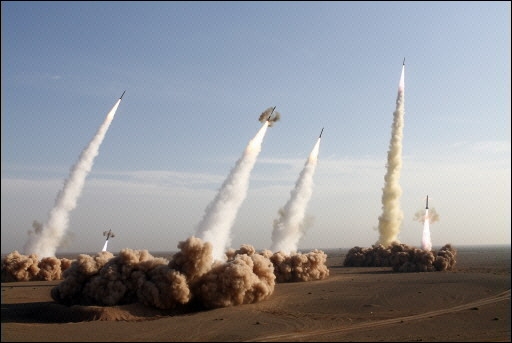  |
|
Iran launches "dozens of Sharab-2 and -3,
Zolfaghar-73, Scud B, Fath-110 and Zelzal" missiles during the
10-day Great Prophet 2 exercise in November 2006. This
included the first-ever launch of the Shahab-3 (although this may
have in fact been the Shahab-3 variant, sometimes called Sharab-4). |
Developing Nations and Warhead Dynamic Performance
Recently, it was suggested that the developing nations missile program warheads would be tumbling about their center of gravity during re-entry, which would then make it difficult to identify. This was because they were not being spun-up along their longitudinal axis prior to re-entry through the atmosphere.
A warhead is much like a bullet fired from a rifle barrel. If the barrel is grooved to spin up the bullet along its longitudinal axis it tends to fly through the atmosphere to its target more smoothly and accurately. If the barrel is not built with this capability, the bullet tumbles uncontrollably about its center of gravity throughout its flight in the atmosphere to its target. This tumbling reduces the accuracy of the projectile.
This kind of missile warhead tumbling was noted in the ballistic flights of Iraqi's Scud-B, Scud-C/Al-Hussein, Scud-D/Al-Abbas ballistic missiles during the Gulf war. In this particular case all of the warheads remained attached to the Scud derived rocket bodies. The length of the Scud-C and D missile bodies and the failure to spin up either the missile with its warhead or separate the warhead after missile spin up made them extremely unstable and in accurate during re-entry to their target.
Today this is not the case with North Korean derived warhead technology. North Korea successfully demonstrated payload spin up with the satellite launch attempt of the Taep'o-dong-1 or PAEUTUSAN-1 booster. The Paeutusan-1 solid propellant third stage both demonstrated a near full duration burn and the spin up of the stage and satellite along its longitudinal axis. However, the third stage solid motor ruptured, de-orbiting the satellite, almost immediately after achieving orbital velocity.
Therefore, it would be correct to assume that besides North Korea's, No-dong (first stage of Taep'o-dong-1), both Pakistan's Ghauri-II and Iran's Shahab-3 all benefit from this spin-up technology. The Shahab-3/Ghauri-II both apparently spin up the single booster stage and warhead combination starting at about 10 seconds before the termination of the powered flight at 110 seconds. At this point after 110 seconds of powered flight the warhead is then separated from the booster stage to fly on a re-entry trajectory that remains stable to its target. With the addition of GPS targeting the warhead accuracy is greatly enhanced. There are still many in the analytical community that question, perhaps correctly, this suggested accuracy of 190 meters to over one kilometer. There can be no doubt that this spin-up technology does improve the accuracy of these warheads over the previously demonstrated poor capability. Since the warheads are not tumbling it in fact enhances the interceptor sensor signature identification capability verses that of a tumbling warheads signature.
Equally revealing is the fact that this is the area where the Iranian Shahab-3 has repeatedly failed in flight test. If the steering vains are not equally positioned correctly or are defective in any way the missile and warhead combination would tumble about its center of gravity out of control destroying the missile. The resulting tumbling warhead whether attached to the remaining missile body or not would in all probability be destroyed during its re-entry. It is known that Iran has and continues to suffer from a steering vain quality control problem for its Shahab-3 ballistic missile that the Germans during WW-II solved and that the United States and former Soviet Union were able to easily resolve with out using specialized coating.

Source: U.S. Department of Defense, Office of the Secretary of
Defense, Proliferation: Threat and Response, January 2001, p. 37.


Sources and Methods
- Bill Gertz, "Missiles In Iran of Concern To State," Washington Times,
September 11, 1997, pp. 1, A14.
- Bill Gertz, "House, seeks sanctions on Russia for Iran arms,"
Washington Times, October 18, 1997, p. A4.
- Bill Gertz, "China assists Iran, Libya on Missiles,"
Washington Times, June 16, 1998, pp. A1, A14.
- Bill Gertz & Martin Sieff, "Iran's missile test alarms Clinton,"
Washington Times, July 24, 1998, pp. A1, A13.
- Walter Pincus, "Iran may soon gain missile capability,"
Washington Post, July 24, 1998.
- Bill Gertz, "Iran tests medium-range missile,"
Washington Times, July 23, 1998.
- James Hackett, "Growing missile threat from Iran,"
Washington Times, March 2, 1999, p. A13.
- "Iran says missile for satellite launching," Florida Today online
(AP Tehran, Iran) February 8, 1999.
- "Iran Revolutionary Guards build new missile,"
Reuters, September 19, 1999.
- Bill Gertz, "Tehran increases range on missiles,"
Washington Times, September 22, 1999.
- Bill Gertz, "N. Korea sells Iran missile engines,"
Washington Times, February 9, 2000, p. A1.
- Bill Gertz, "Critical N. Korean missile parts seen aiding Iran's Program,"
Washington Times, February 10, 2000, p. A3.
- Steve Rodan, "Iran now able to deploy Shahab-3,"
Jane's Defence Weekly, March 22, 2000.
- "Iran tests upgraded missile able to hit Israel", Reuters news reports,
Washington Times, 16, July 2000, p. C3.
- Bill Gertz, "Iran set for another flight test of missile," Washington Times,
September 8, 2000, pp. 1, A20.
- "Iran: Shahab-3 "non-military" missile successfully test-fired,"
Voice of the Islamic Republic of Iran Radio-1, September 21, 2000.
- "Iran test-fires missile,"
Associated Press, September 22, 2000.
- Bill Gertz, "Iran's missile test fails after takeoff,"
Washington Times, September 22, 2000, p. A5.
- Andrew Koch, "Third Iranian Shahab test "a fizzle","
Jane's Intelligence Review, November 2000, p. 5.
- Iran's Ballistic Missile and Weapons of Mass Destruction Programs, Hearing before the International Security, Proliferation, and Federal Services Subcommittee of the Committee on Governmental Affairs, United States Senate, September 21, 2000.
- Bill Gertz and Rowan Scarborough, "Shahab-3 test set," (Inside the Ring), Washington Times, January 12, 2001, p. A8.
- Bill Gertz and Rowan Scarborough, "North Korea-Iran spat," Inside the Ring,
Washington Times, April 27, 2001, p. A9.
- U.S. Air Force, National Air and Space Intelligence Center,
Ballistic
and Cruise Missile Threat, March 2006.
- "Iran fires longer-range
missiles, to West's dismay," Agence France-Presse, November 3, 2006.
http://www.fas.org/nuke/guide/iran/missile/shahab-3.htm
Maintained by Hans M. Kristensen
Updated: December 14, 2006










